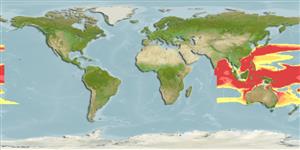>
Myctophiformes (Lanternfishes) >
Myctophidae (Lanternfishes) > Lampanyctinae
Eponymy: Dr Rolf Ling Bolin (1901–1973) was an American ichthyologist and marine biologist who was a specialist in lanternfish. [...] (Ref. 128868), visit book page.
More on author: Alcock.
Environment: milieu / climate zone / Tiefenbereich / distribution range
Ökologie
seewasser pelagic-oceanic; tiefenbereich 60 - 778 m (Ref. 280). Deep-water
Indo-Pacific.
Size / Gewicht / Alter
Geschlechtsreife: Lm ? range ? - ? cm
Max length : 9.2 cm SL Männchen/unbestimmt; (Ref. 96467)
An oceanic, mesopelagic fish with some size stratification with respect to depth: small specimens (<2.3 cm SL) were taken in nets as shallow as 60 m, while specimens >4.0 cm SL have only been taken in trawls fished to 490 m and deeper. During daytime minimal catch data indicate that the species is not found in the upper 500 m, but at night, small specimens (< ca. 2.5 cm SL) may migrate into the upper 120 m. Mature and expended females (Stages V and VI) have been caught in January and April, suggesting late summer spawning period (Ref. 96467).
Life cycle and mating behavior
Geschlechtsreife | Fortpflanzung | Ablaichen | Eier | Fecundity | Larven
Paxton, J.R., D.F. Hoese, G.R. Allen and J.E. Hanley, 1989. Pisces. Petromyzontidae to Carangidae. Zoological Catalogue of Australia, Vol. 7. Australian Government Publishing Service, Canberra, 665 p. (Ref. 7300)
IUCN Rote Liste Status (Ref. 130435: Version 2024-2)
Bedrohung für Menschen
Harmless
Nutzung durch Menschen
Tools
Zusatzinformationen
Download XML
Internet Quellen
Estimates based on models
Preferred temperature (Ref.
123201): 9.7 - 21.3, mean 13.8 °C (based on 370 cells).
Phylogenetic diversity index (Ref.
82804): PD
50 = 0.5078 [Uniqueness, from 0.5 = low to 2.0 = high].
Bayesian length-weight: a=0.00871 (0.00318 - 0.02383), b=3.00 (2.76 - 3.24), in cm total length, based on LWR estimates for this (Sub)family-body shape (Ref.
93245).
Trophic level (Ref.
69278): 3.1 ±0.1 se; based on size and trophs of closest relatives
Widerstandsfähigkeit (Ref.
120179): hoch, Verdopplung der Population dauert weniger als 15 Monate. (Preliminary K or Fecundity.).
Fishing Vulnerability (Ref.
59153): Low vulnerability (10 of 100).
🛈
